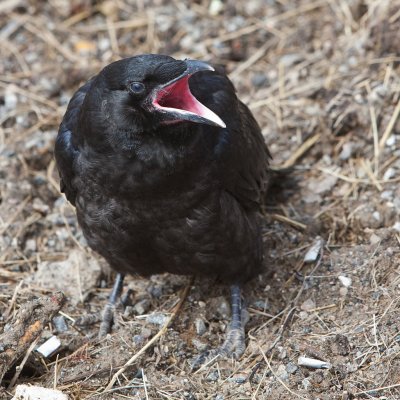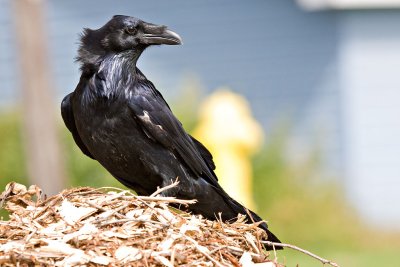Reproduction

Common ravens reproduce sexually and as defined by the kingdom animalia have young that develop in embryonic layers. These embryonic layers can be found in the eggs of Corvus corax. The number of eggs produced by the female range from three to seven and is a mixture of colors: light and greenish blue, green or brownish green with a number of spotted dots of brown or dark brown coloring. Female common ravens are the only ones that incubate these eggs while the young are in embryonic development (Goodwin 1986).
Click Here to see baby common ravens!
It is believed that the common raven is monogamous and mates for
life (National Geographic 2012).
 Mating
season for the common raven usually starts around mid February and
runs until late May. In order to attract the attention of potential
female mates during this time, males will present themselves in an erect posture
fluffing up their head, spreading their wings, and bowing to the
female as they make gurgling and clicking noises as they
consecutively open and close their beaks (Boarmen 1999). Aerial
acrobatic displays are also important in the process of acquiring a
mate. Male common ravens can often be found diving, rolling, and
chasing females in order to gain their attention and favor (National
Geographic 2012). Go to Adaptations to see
how recent observations show that common ravens make bonds by giving
non-edible objects to one another.
Mating
season for the common raven usually starts around mid February and
runs until late May. In order to attract the attention of potential
female mates during this time, males will present themselves in an erect posture
fluffing up their head, spreading their wings, and bowing to the
female as they make gurgling and clicking noises as they
consecutively open and close their beaks (Boarmen 1999). Aerial
acrobatic displays are also important in the process of acquiring a
mate. Male common ravens can often be found diving, rolling, and
chasing females in order to gain their attention and favor (National
Geographic 2012). Go to Adaptations to see
how recent observations show that common ravens make bonds by giving
non-edible objects to one another.
Click Here to observe a mated pair of common ravens!
Both male and female members of the species Corvus corax
take care of and tend to their young. Although both sexes share
parental care, the female is the only one to brood the young. When
the female is inclined to leave the presence of her young, the male
will stand over and protect his offspring,
without actually brooding them within the nest (Goodwin 1986). The
nests of Corvus corax are usually located in high proximity
to the ground. Nest location varies between high inland ridges,
coastal sea ledges, trees, and even buildings (Boarmen 1999). Most of these nests
are covered by an outcropping from above and are constructed from an
assortment of materials including: sticks, stems, moss and dirt
(outer part) as well as hair, fur, wool, and grass (inner part)
(Goodwin 1986).
usually located in high proximity
to the ground. Nest location varies between high inland ridges,
coastal sea ledges, trees, and even buildings (Boarmen 1999). Most of these nests
are covered by an outcropping from above and are constructed from an
assortment of materials including: sticks, stems, moss and dirt
(outer part) as well as hair, fur, wool, and grass (inner part)
(Goodwin 1986).
Click Here to see the common raven (northern raven) in its nest!
Go to Interactions to see how the common raven intermingles with other creatures!
Back to Top
Back to Homepage
